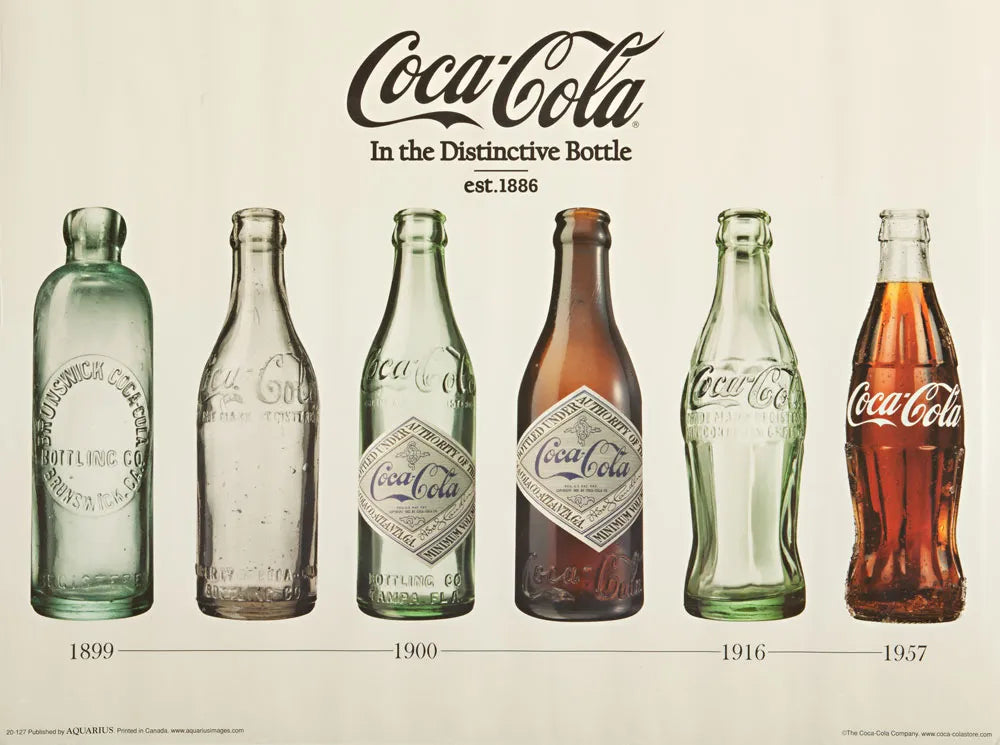Your Cart is Empty
Free and Fast Shipping | 30 Day Money Back Guarantee
Free and Fast Shipping | 30 Day Money Back Guarantee
Free and Fast Shipping | 30 Day Money Back Guarantee

Coca-Cola has not only quenched the thirst of billions but has also become a symbol of American culture, entrepreneurial brilliance, and ingenious marketing. The story of this iconic beverage spans over a century, filled with innovation, globalization, and the creation of a brand that transcends geographical and cultural boundaries. Below, we dive deep into each chapter of Coca-Cola's remarkable
history.
Coca-Cola originated as a medicinal concoction created by Dr. John Stith Pemberton i
n 1886. The Atlanta-based pharmacist initially wanted to produce an over-the-counter cure to relieve headaches, fatigue, and morphine addiction, a personal struggle for him. The original mixture combined carbonated water with a syrup made from extracts of the coca leaf and kola nut, among other ingredients. Though it was initially sold as a 'patent medicine,' Coca-Cola's enjoyable taste quickly made it popular as a soda fountain drink at Jacobs' Pharmacy in Atlanta.
After Dr. Pemberton's death in 1888, the Coca-Cola formula and brand were acquired by Asa Griggs Candler, an Atlanta businessman, for a mere $2,300. Candler was the force that truly launched Coca-Cola into commercial success. His innovative promotional strategies ranged from distributing Coca-Cola coupons for free samples to investing in massive advertising campaigns, including wall murals and branded merchandise like clocks and calendars. He also expanded the distribution network, moving Coca-Cola beyond soda fountains and into bottled distribution. By the early 1900s, Coca-Cola had become a household name, thanks in large part to Candler's unyielding focus on brand visibility.

With success came imitation, and soon the market was flooded with "Cola" drinks trying to mimic Coca-Cola's winning formula. This prompted the company to seek a distinctive, trademarked bottle design that could set Coca-Cola apart from its imitators. The Root Glass Company took on the challenge and, in 1915, came up with the unique "contour" design. Inspired by the coca bean's shape, this bottle was distinct enough to be recognized by touch alone and even in the dark. This iconic bottle would become one of the most recognized pieces of industrial design in the world.

Coca-Cola had been making inroads into global markets since the early 20th century, but World War II accelerated this expansion. The company provided the beverage to U.S. military personnel stationed overseas, endearing the brand to soldiers and establishing it as an icon of American culture. Following the war, Coca-Cola seized the opportunity to set up bottling plants in several countries, facilitating rapid global distribution.
The post-war era saw Coca-Cola becoming more than just a beverage—it evolved into a cultural icon. Campaigns like "I'd Like to Buy the World a Coke" struck a chord with audiences, encapsulating sentiments of unity and global friendship. Over the years, Coca-Cola commercials featuring celebrities and musicians helped cement its status as a lifestyle brand, closely linked to youth, joy, and a carefree way of life.
In the face of rising health concerns regarding sugar and obesity, Coca-Cola has diversified its product range to include Diet Coke, Coke Zero, and other non-cola beverages such as teas, juices, and mineral waters. The company has also taken significant steps towards sustainability, reducing plastic use and aiming for a more eco-friendly production cycle.
Coca-Cola now faces challenges from an increasingly health-conscious consumer base, as well as growing competition from a variety of beverage alternatives. Nevertheless, it remains a formidable player, using its historical strength in branding and marketing to adapt and evolve.
Comments will be approved before showing up.
Tha Quality was fantastic❗❗❗
Used grease or lard bucket was carried under rear axle to periodically grease wheel hubs. Very good video.
I'm super impressed how quickly the print got to Canada and the quality is worth every penny. Thank you so much, Gordon Parks is a hero to my partner and I'm sure he will love this surprise
Received as a gift and could not be happier with the quality of the print. Shipping container ensure this arrived in perfect condition.
Love the simplicity and vintage feel of this print. Plus- prickly + beauty theme.
Wow. What an incredible photograph, and I love the story behind it as well. Seller does excellent work, and I couldn't be more pleased.
Amazing photograph and beautifully reproduced. Excellent work and shipped quickly. Thanks so much.
Beautiful photo and amazing quality!
5 stars review from Claire
Image quality and the extent to which the image was packaged securely was perfect. Could not be happier with the product.
This image along with much of Thomas Hines' work is incredibly powerful. The brutality faced by these children makes our everyday hardships seem frivolous.
5 stars review from Pjewc191
Great item. Packed well for shipping. Shipped quickly.
arrived quickly and looks great!
Classic. Framed it, and hung it up.